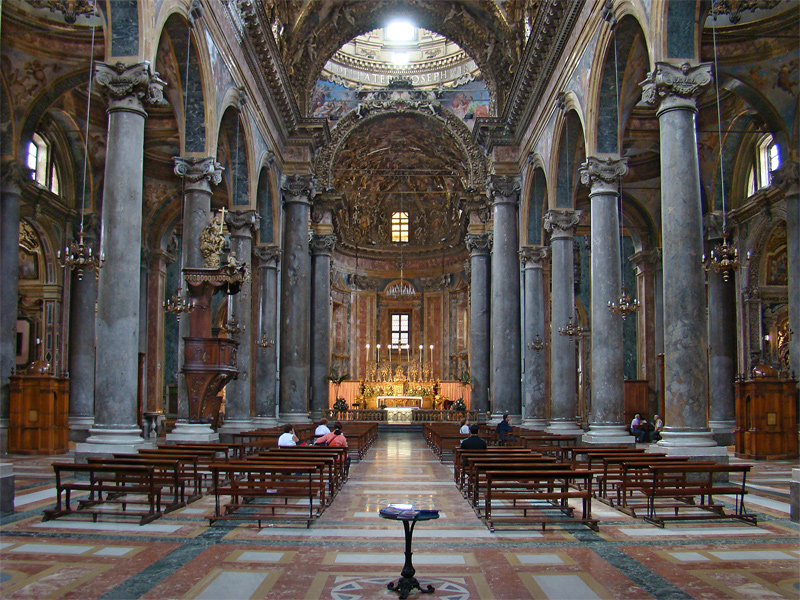San Giuseppe dei Teatini on:
[Wikipedia]
[Google]
[Amazon]
 San Giuseppe dei Teatini is a
San Giuseppe dei Teatini is a
Description page in Italian
{{DEFAULTSORT:Giuseppe Dei Teatini Palermo 17th-century Roman Catholic church buildings in Italy Giuseppe dei Teatini San Giuseppe dei Teatini Palermo Church buildings with domes Theatine churches Sicilian Baroque
 San Giuseppe dei Teatini is a
San Giuseppe dei Teatini is a Roman Catholic
Roman or Romans most often refers to:
*Rome, the capital city of Italy
* Ancient Rome, Roman civilization from 8th century BC to 5th century AD
* Roman people, the people of ancient Rome
*'' Epistle to the Romans'', shortened to ''Romans'', a let ...
church on via Vittorio Emanuele, at the southwest corner of the Quattro Canti
Quattro Canti, officially known as Piazza Vigliena, is a Baroque square in Palermo, region of Sicily, Italy; it is considered the center of the historic quarters of the city. The site is the intersection of two major streets in Palermo, the Via Maq ...
, in the historic center of the city of Palermo, region of Sicily
(man) it, Siciliana (woman)
, population_note =
, population_blank1_title =
, population_blank1 =
, demographics_type1 = Ethnicity
, demographics1_footnotes =
, demographi ...
, Italy. The east flank of the nave faces the Fontana Pretoria, across the piazza from Santa Caterina. San Giuseppe is an example of the Sicilian Baroque
Sicilian Baroque is the distinctive form of Baroque architecture which evolved on the island of Sicily, off the southern coast of Italy, in the , when it was part of the Spanish Empire. The style is recognisable not only by its typical Baroque c ...
in Palermo.
History
The church was built at the beginning of the 17th century by Giacomo Besio, a Genoese member of theTheatine
The Theatines officially named the Congregation of Clerics Regular ( la, Ordo Clericorum Regularium), abreviated CR, is a Catholic order of clerics regular of Pontifical Right for men founded by Archbishop Gian Pietro Carafa in Sept. 14, 1524. I ...
order. It has a majestic though simple façade. In the centre niche is housed a statue of San Gaetano, founder of the order. Another striking feature is the large dome with a blue and yellow majolica
In different periods of time and in different countries, the term ''majolica'' has been used for two distinct types of pottery.
Firstly, from the mid-15th century onwards, was ''maiolica'', a type of pottery reaching Italy from Spain, Majorca a ...
covering. The tambour
In classical architecture, a tambour ( Fr.: "drum") is the inverted bell of the Corinthian capital around which are carved acanthus leaves for decoration.
The term also applies to the wall of a circular structure, whether on the ground or rais ...
decorated with double columns, and was designed by Giuseppe Mariani. The belfry tower was designed by Paolo Amato.
The interior has a Latin cross plan with a nave and two aisles, divided by marble columns of variable height. The inner decoration is a nearly overwhelming parade of Baroque art
The Baroque (, ; ) is a style of architecture, music, dance, painting, sculpture, poetry, and other arts that flourished in Europe from the early 17th century until the 1750s. In the territories of the Spanish and Portuguese empires including t ...
, with stuccoes by Paolo Corso and Giuseppe Serpotta. Frescoes decorate the nave ceiling and the transept vault, painted by Filippo Tancredi, Guglielmo Borremans
Guglielmo Borremans or Guglielmo Fiamingo (1670–1744) was a Flemish painter whose documented career took principally place in Italy, in particular Naples, Cosenza and Sicily. Here he was one of the pre-eminent late-Baroque fresco painters of th ...
and Giuseppe Velasquez
Giuseppe Velasquez, Velasques or Velasco (16 December 1750 – 7 February 1827) was an Italian painter, active in a Neoclassic style.
Biography
He was born at Palermo into Spanish family; his father was Fabiano Ungo de Velasco. At the age o ...
. The frescoes were severely damaged during World War II
World War II or the Second World War, often abbreviated as WWII or WW2, was a world war that lasted from 1939 to 1945. It involved the vast majority of the world's countries—including all of the great powers—forming two opposing ...
, but have been accurately restored. The most important piece of art is however a wood crucifix by Fra' Umile of Petralia.
The crypt houses remains of a former church, dedicated to Madonna of Providence.
References
Description page in Italian
{{DEFAULTSORT:Giuseppe Dei Teatini Palermo 17th-century Roman Catholic church buildings in Italy Giuseppe dei Teatini San Giuseppe dei Teatini Palermo Church buildings with domes Theatine churches Sicilian Baroque